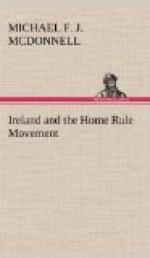1898, and in the succeeding years the number steadily
diminished, so that they amounted in 1899 to 6,000,
in 1900 to 5,000, and in 1901 to only 3,000.
The reasons for this are not difficult to find.
The payment in Consols was profitable so long as securities
stood at a high figure, but the expenses arising from
the South African war resulted in a fall of Stocks
from 112 to 85, and as a result new terms for land
purchase became imperatively needed. In consequence
Mr. Wyndham brought in a Bill in 1902, which was,
however, stillborn, but its withdrawal was accompanied
with a promise of legislation in the following session.
The situation in the winter of 1902 was critical.
An Irish Land Trust had been formed by the landlords
to oppose the United Irish League, and on the 1st
of September there was issued a Viceregal proclamation,
putting the Coercion Act in force in Dublin and Limerick.
By a curious coincidence, the papers published the
same day a letter from Captain Shaw Taylor, an Irish
landlord, inviting representatives of tenants and
landlords to meet in conference in Dublin and discuss
a way out of the agrarian
impasse. The
proposal was scouted by the
Times, the
Daily
Express, and the Dublin
Daily Express, but
was favourably received by the Press in other quarters.
A motion by Lord Mayo at the Landowners’ Convention,
in favour of the conference, was rejected by 77 votes
to 14. A poll on the question being demanded,
4,000 landlords, each with an estate of more than
500 acres, received voting papers, and of these 1,706
replied, 1,128 in favour and 578 against a conference,
while the small landlords were almost unanimously
in its favour. A second appeal was then made
to the Landowners’ Convention through its president,
Lord Abercorn, but an answer in the negative was received,
for it went on to say—“It would be
merely to give long-discredited politicians a certificate
of good sense and of just views, we might almost say
of legislative capacity to sit in an Irish Parliament
in Dublin, were we to accept Captain Shaw Taylor’s
invitation to join them.”
The criticism of an unbiassed foreign observer on
this attitude of rigid cast-iron non possumus
is instructive. “Rappelons nous,”
writes M. Bechaux, “que le parti irlandais au
Parlement, si grossierement insulte represente 4/5
du peuple irlandais, nous avons un specimen de l’esprit
reactionnaire et irreconciliable du landlordisme irlandais.”
In spite of this the Conference met at the end of
the year. The landlords’ representatives
were:—Lord Dunraven, Lord Mayo, Col.
Hutcheson Poee, and Col. Nugent Everard; and
those of the tenants were:—Mr. John Redmond,
Mr. W. O’Brien, Mr. T.W. Russell, and Mr.
T.C. Harrington. On the 3rd January, 1903,
a joint report to serve as the basis of the new Bill
was issued.




